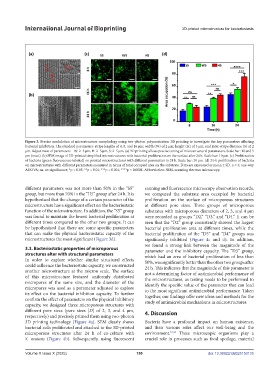Page 167 - v11i4
P. 167
International Journal of Bioprinting 3D-printed microstructure for bacteriostasis
Figure 3. Precise modulation of microstructure morphology using two-photon polymerization 3D printing to investigate the key parameters affecting
bacterial inhibition. The standard parameters: stripe lengths of 4, 8, and 16 μm; width (W) of 2 μm; height (H) of 3 μm; and inter-stripe distance (S) of 2
μm. Adjustment of parameters—W: 2–5 μm, H: 2–5 μm, S: 2–5 μm. (a) 3D printing allows precise tuning of microstructural parameters. Scale bar: 10 and 5
μm (inset). (b) SEM image of 3D-printed simplified microstructures with bacterial proliferation on the surface after 24 h. Scale bar: 10 μm. (c) Proliferation
of bacteria (green fluorescence-labeled) on printed microstructures with different parameters in 24 h. Scale bar: 30 μm. (d) 24-h proliferation of bacteria
on microstructures with different parameters measured in terms of total occupied area on the substrate. Data are expressed as mean ± SD. n = 3; one-way
ANOVA; ns, no significance; *p < 0.05; **p < 0.01; ***p < 0.001; ****p < 0.0001. Abbreviation: SEM, scanning electron microscopy.
different parameters was not more than 50% in the “S5” staining and fluorescence microscopy observation records,
group, but more than 70% in the “H5” group after 24 h. It is we compared the substrate area occupied by bacterial
hypothesized that the change of a certain parameter of the proliferation on the surface of microporous structures
microstructure has a significant effect on the bacteriostatic at different pore sizes. Three groups of microporous
function of the microstructure. In addition, the “S5” group substrates with microporous diameters of 2, 3, and 4 μm
was found to maintain the lowest bacterial proliferation at were recorded as groups “D2,” “D3,” and “D4.” It can be
different times compared to the other two groups. It can seen that the “D2” group consistently showed the largest
be hypothesized that there are some specific parameters bacterial proliferation area at different times, while the
that can make the physical bacteriostatic capacity of the bacterial proliferation of the “D3” and “D4” groups was
microstructures the most significant (Figure 3d). significantly inhibited (Figure 4c and d). In addition,
we found a strong link between the magnitude of the
3.3. Bacteriostatic properties of microporous parameter and the inhibitory capacity. The “D3” group,
structures alter with structural parameters which had an area of bacterial proliferation of less than
In order to explore whether similar structural effects 50%, was significantly better than the other two groups after
could influence the bacteriostatic capacity, we constructed 24 h. This indicates that the magnitude of this parameter is
another microstructure at the micron scale. The surface not a determining factor of antimicrobial performance of
of this microstructure featured uniformly distributed the microstructures, as testing needs to be performed to
micropores of the same size, and the diameter of the identify the specific value of the parameter that can lead
micropores was used as a parameter adjusted to explore to the most significant antimicrobial performance. Taken
its effect on the bacterial inhibition capacity. To further together, our findings offer new ideas and methods for the
confirm the effect of parameters on the physical inhibitory study of antimicrobial mechanisms in microstructures.
capacity, we designed three microporous structures with
different pore sizes (pore sizes [D] of 2, 3, and 4 μm, 4. Discussion
respectively) and precisely printed them using two-photon
3D printing technology (Figure 4a). SEM clearly shows Bacteria have a profound impact on human existence,
bacterial cells proliferated and attached to the 3D-printed and their various roles affect our well-being and the
microporous structures after 24 h of co-culture with environment. 34,35 These microscopic organisms play a
S. mutans (Figure 4b). Subsequently, using fluorescent crucial role in processes such as food spoilage, material
Volume X Issue X (2025) 159 doi: 10.36922/IJB025150135

